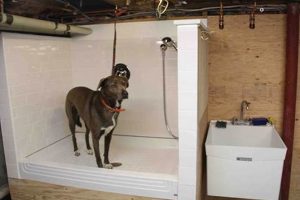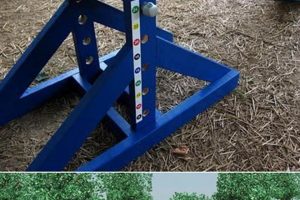The construction of mobility devices for canines experiencing hind limb weakness or paralysis, utilizing readily available materials and do-it-yourself methodologies, represents a cost-effective alternative to commercially manufactured options. These customized aids provide support and facilitate ambulation for dogs with various conditions, enabling them to maintain an active lifestyle. As an example, a user might construct a wheeled support using PVC pipes, straps, and wheels sourced from a hardware store.
This practice offers numerous advantages, including reduced expense compared to purchasing a ready-made wheelchair, the ability to tailor the device to the specific measurements and needs of the animal, and the potential for ongoing adjustments as the dog’s condition evolves. Historically, owners have adapted carts and other assistive devices for animals facing mobility challenges. The current focus on DIY solutions is largely facilitated by online communities, instructional videos, and readily accessible resources.
The following sections will delve into the necessary materials, construction techniques, safety considerations, and factors to consider when undertaking such a project. Special attention will be paid to ensuring the comfort and well-being of the animal throughout the design and utilization of a homemade mobility aid.
Constructing a Canine Mobility Device
The successful creation and implementation of a dog wheelchair hinges on meticulous planning, accurate measurements, and a thorough understanding of the animal’s specific needs. The following tips provide guidance for a safe and effective outcome.
Tip 1: Precise Measurement is Paramount: Obtain accurate measurements of the dogs height at the withers, body length from chest to rear, and width across the torso. These measurements will dictate the dimensions of the frame and ensure a proper fit.
Tip 2: Material Selection for Durability and Safety: Opt for lightweight yet robust materials such as PVC pipe, aluminum tubing, or reinforced plastics. Ensure all materials are non-toxic and free of sharp edges or protrusions that could cause injury.
Tip 3: Prioritize Adjustability: Design the wheelchair with adjustable components, including height, width, and strap placement. This allows for fine-tuning the fit as the dog’s condition changes or as the device settles with use.
Tip 4: Secure and Comfortable Harnessing: Implement a well-padded harness system that distributes weight evenly across the dog’s chest and abdomen. Avoid pressure points that could lead to chafing or discomfort. Consider using fleece or neoprene padding.
Tip 5: Wheel Selection Based on Terrain: Choose appropriate wheel size and type based on the primary terrain where the wheelchair will be used. Larger wheels are suitable for uneven surfaces, while smaller wheels offer greater maneuverability on smooth surfaces.
Tip 6: Gradual Introduction and Training: Introduce the wheelchair gradually, allowing the dog to acclimate to the device in a controlled environment. Use positive reinforcement to encourage acceptance and movement.
Tip 7: Regular Monitoring and Maintenance: Regularly inspect the wheelchair for wear and tear, loose connections, or damage. Replace any worn or damaged components promptly to ensure continued safety and functionality.
Tip 8: Consult with Veterinary Professionals: Seek guidance from a veterinarian or veterinary rehabilitation specialist to ensure the wheelchair design is appropriate for the dog’s specific condition and to receive advice on proper fitting and usage.
Adherence to these considerations will contribute to the construction of a safe, comfortable, and effective canine mobility device, enhancing the animal’s quality of life and promoting continued activity.
The subsequent sections will focus on specific design plans and construction methods, building upon the foundational principles outlined above.
1. Measurements
In the context of do-it-yourself dog wheelchairs, accurate measurements are paramount. These figures serve as the foundation upon which the entire structure is built, directly influencing the device’s functionality, comfort, and safety. Deviations from accurate measurements can render the wheelchair ineffective or, worse, cause injury to the animal.
- Height at Withers
The vertical distance from the ground to the highest point of the dog’s shoulder blades (withers) determines the height of the wheelchair’s support structure. Insufficient height will force the dog to hunch, causing discomfort and impeding movement. Conversely, excessive height may lead to instability and an increased risk of tipping. For instance, a discrepancy of even one inch can significantly alter the dog’s posture within the device.
- Body Length (Chest to Rear)
This measurement dictates the overall length of the wheelchair frame. Too short of a frame restricts the dog’s natural stride and can cause the rear legs to drag unnecessarily. An overly long frame can be cumbersome and difficult for the dog to maneuver, especially in confined spaces. A practical example is observing a dog’s natural gait to determine the ideal frame length, ensuring unrestricted movement.
- Width Across Torso
The width of the dog’s torso informs the spacing of the wheelchair’s side supports. Insufficient width can cause chafing and restrict breathing, while excessive width can compromise stability. Consider the dog’s rib cage expansion during respiration when determining this measurement. The goal is to create a snug, supportive fit without causing undue pressure.
- Leg Length (Optional, but Recommended)
If the dog has partial use of its hind legs, measuring the leg length from the hip to the paw (or to the point of contact with the ground) helps determine the amount of support required from the wheelchair. This measurement aids in setting the height of any stirrups or support structures designed to keep the legs from dragging. Using this measurement can help to create a more supportive, functional chair rather than simply something that provides mobility.
The careful collection and application of these measurements are indispensable to the successful creation of a functional and safe dog wheelchair. These figures are not merely dimensions; they are the key to unlocking improved mobility and quality of life for the animal. Disregarding their importance can lead to significant complications and undermine the entire purpose of the undertaking.
2. Material Selection
Material selection represents a critical juncture in the do-it-yourself dog wheelchair creation process. The materials chosen directly impact the wheelchair’s weight, durability, stability, and, most importantly, the safety and comfort of the animal. Inappropriate materials can lead to structural failures, discomfort, or even injury. The selection process should be guided by a thorough understanding of material properties and their suitability for the intended application.
For example, PVC pipe is often utilized for its lightweight nature, affordability, and ease of assembly. However, standard PVC may lack the necessary strength for larger dogs or for use in rough terrain, potentially resulting in fractures or collapses. Conversely, aluminum tubing offers superior strength and durability but presents challenges in terms of cutting, bending, and joining, requiring specialized tools and skills. Strap materials, such as nylon webbing, must be chosen for their strength, resistance to abrasion, and comfort against the dog’s skin. A poorly chosen strap can cause chafing, pressure sores, or even restrict circulation. The selection of wheels should also consider weight capacity, rolling resistance, and terrain suitability. Small, hard wheels may be adequate for indoor use but prove ineffective and uncomfortable on grass or gravel.
In conclusion, the selection of materials for a dog wheelchair directly dictates its functionality, safety, and longevity. Careful consideration must be given to factors such as the dog’s size, weight, activity level, and the intended use environment. Prioritizing high-quality, durable, and appropriate materials is essential for creating a safe and effective mobility aid that enhances the animal’s quality of life. The interplay between material properties and the specific needs of the dog highlights the importance of informed decision-making throughout the DIY construction process.
3. Adjustability
The element of adjustability is fundamental to the effective design and construction of canine mobility aids, particularly within the realm of do-it-yourself projects. A static, non-adjustable wheelchair often proves unsuitable due to variations in canine anatomy, changes in physical condition, and the dynamic nature of the environments in which the device is utilized.
- Height Adjustment
The ability to modify the wheelchair’s height is crucial for accommodating dogs of differing sizes and for adapting to changes in a dog’s posture or muscle tone over time. If the height is fixed, the dog may be forced to hunch over, leading to discomfort and potential spinal strain, or the support may be inadequate. An adjustable height allows for fine-tuning the device to maintain a neutral spine position, promoting comfort and efficient locomotion. For instance, a simple locking pin system along the vertical supports can provide incremental height adjustments.
- Width Adjustment
Adaptability in width is essential for ensuring a secure yet comfortable fit around the dog’s torso. A wheelchair that is too narrow restricts breathing and can cause chafing, while one that is too wide compromises stability. Adjustable side supports, often incorporating sliding mechanisms or adjustable straps, allow for accommodating changes in the dog’s weight or muscle mass. This adaptability is particularly valuable for growing puppies or dogs undergoing rehabilitation.
- Strap and Harness Positioning
The positioning of the harness and supporting straps significantly impacts the distribution of weight and the overall comfort of the device. The ability to adjust the length and angle of these straps allows for optimizing the fit to the dog’s unique body shape and ensuring that pressure is evenly distributed. Adjustable straps can also prevent rubbing and chafing, which are common issues with ill-fitting mobility devices. Consider using buckles or sliders to allow modifications.
- Wheel Position and Angle
The positioning and, potentially, the angle of the wheels can be adjusted to further customize the wheelchair to the dog’s gait and the terrain on which it will be used. Adjusting the wheel position can affect turning radius and stability. Consider the possibility of adjustable wheel axles to fine-tune the wheelchair’s performance.
The incorporation of adjustable features into a do-it-yourself dog wheelchair design necessitates a more complex construction process but yields a more adaptable and comfortable mobility aid. The ability to fine-tune the device to the dog’s specific needs and adapt to changes in their physical condition ultimately enhances the animal’s quality of life and prolongs the usefulness of the wheelchair.
4. Harness Design
Harness design constitutes an integral, non-separable component of “dog wheelchair diy.” It functions as the primary interface between the animal and the mobility device, dictating comfort, stability, and the distribution of force. A poorly designed harness can negate the benefits of an otherwise well-constructed wheelchair, leading to discomfort, chafing, and even injury. Conversely, a meticulously designed harness maximizes the wheelchair’s efficacy by ensuring proper weight distribution and preventing undue strain on specific anatomical regions.
The design should consider the dog’s anatomy, accounting for variations in breed, size, and body condition. The harness must distribute pressure evenly across the sternum and rib cage, avoiding concentrated pressure points that could lead to skin irritation or respiratory distress. The materials chosen should be both durable and breathable, minimizing friction and moisture buildup. For example, using fleece padding on areas of high contact, such as around the chest and abdomen, can significantly improve comfort. Furthermore, the harness must be securely attached to the wheelchair frame, preventing slippage or detachment during use. Examples of successful designs often incorporate adjustable straps to accommodate individual differences and changes in body condition, as well as quick-release buckles for ease of application and removal.
Therefore, effective harness design is not merely an accessory but a fundamental element of dog wheelchair creation. A well-engineered harness enhances comfort, improves stability, and ensures the safe and effective utilization of the mobility device, improving the animal’s quality of life and enabling continued activity. Neglecting this critical aspect undermines the entire purpose of the project.
5. Wheel type
Wheel selection is a crucial determinant of a do-it-yourself dog wheelchair’s overall performance and suitability for its intended use. The wheel type directly impacts the ease of propulsion, stability, maneuverability, and the level of comfort experienced by the animal. Inappropriate wheel selection can negate the benefits of a well-designed frame and harness, rendering the device ineffective or even detrimental to the dog’s mobility. For instance, small, rigid wheels are unsuitable for uneven terrain such as grass or gravel, requiring excessive effort from the dog and potentially causing instability. Conversely, large, pneumatic tires may be appropriate for off-road use but can be cumbersome and difficult to maneuver indoors.
The relationship between wheel type and surface compatibility must be carefully considered. Harder, narrower wheels generally perform better on smooth, hard surfaces like sidewalks or indoor flooring, offering lower rolling resistance. Wider, softer wheels provide better traction and shock absorption on uneven surfaces, enhancing stability and reducing strain on the dog’s joints. The wheel diameter also influences the overall effort required for propulsion; larger diameter wheels cover more ground per revolution but may require more initial force to initiate movement. Furthermore, the bearing quality and construction of the wheel assembly affect rolling efficiency and longevity. Substandard bearings increase friction, making the wheelchair harder to push and requiring more frequent maintenance. A practical example includes the selection of puncture-resistant tires for use in environments prone to sharp debris, preventing mobility interruptions.
In summary, wheel type is not merely an aesthetic consideration in the context of canine mobility devices. It is a fundamental engineering parameter that significantly impacts the device’s functionality and the animal’s comfort and safety. A comprehensive understanding of the relationship between wheel characteristics and environmental conditions is essential for successful dog wheelchair DIY. Failure to adequately consider wheel type can result in a device that is difficult to use, uncomfortable for the dog, and ultimately, fails to achieve its intended purpose of restoring mobility and improving quality of life.
6. Training
The integration of a canine into a mobility device, particularly within the framework of do-it-yourself wheelchair construction, necessitates a structured training regimen. This training phase is not an optional addendum but an essential component, directly influencing the animal’s acceptance of the device, its safe and effective utilization, and the prevention of behavioral issues arising from discomfort or anxiety.
- Positive Reinforcement Introduction
Initial exposure to the wheelchair should be gradual and paired with positive reinforcement techniques. Treats, verbal praise, and gentle petting can be utilized to create positive associations with the device. Forceful introduction or prolonged exposure without positive reinforcement can induce anxiety and resistance, hindering the training process. For example, placing the wheelchair in the dog’s vicinity during feeding times can help desensitize the animal to its presence.
- Assisted Movement and Gradual Acclimation
Once the dog exhibits comfort near the wheelchair, assisted movement can be initiated. Initially, this may involve simply placing the dog’s paws on the ground while supported by the wheelchair, gradually increasing the duration of weight-bearing as tolerance improves. Avoid pushing the animal beyond its comfort level, as this can create negative associations. Small steps and patience are crucial. For example, starting with 5-minute sessions and gradually increasing the duration by 5 minutes each day, contingent on the dog’s comfort, represents a progressive acclimation strategy.
- Navigational Training and Environmental Adaptation
Following successful acclimation to the device, navigational training should commence. This involves guiding the dog through various environments, starting with controlled indoor spaces and gradually progressing to outdoor settings. Obstacles, such as doorways and ramps, should be introduced gradually to enhance the dog’s confidence and maneuverability. The handler must provide clear guidance and encouragement, reinforcing successful navigation with positive reinforcement. Navigating a small obstacle course with verbal encouragement and treats can exemplify this training facet.
- Ongoing Monitoring and Adjustment
Throughout the training process, continuous monitoring of the dog’s physical and behavioral responses is essential. Any signs of discomfort, pain, or anxiety should prompt immediate adjustments to the wheelchair’s fit or the training regimen. Consultation with a veterinary professional or canine rehabilitation specialist can provide valuable insights and guidance. For instance, observing changes in gait or posture during wheelchair use can indicate the need for harness or frame adjustments.
The implementation of a structured training program, incorporating positive reinforcement, gradual acclimation, and ongoing monitoring, is indispensable for successful integration of a canine into a do-it-yourself mobility device. This concerted effort ensures the animal’s safety, comfort, and overall well-being, maximizing the potential benefits of the wheelchair and enhancing its quality of life.
7. Maintenance
Sustained functionality and safety in do-it-yourself dog wheelchairs are directly contingent upon consistent and thorough maintenance practices. The absence of a structured maintenance schedule can lead to component failure, reduced mobility assistance, and potential harm to the animal. Therefore, maintenance is not a peripheral consideration but a foundational aspect of responsible DIY mobility aid construction and utilization.
- Frame Inspection and Repair
The structural integrity of the wheelchair frame is paramount. Routine inspection for cracks, bends, or loose connections is necessary. PVC frames may be susceptible to fractures under stress, while metal frames can develop weakened joints due to corrosion or physical impact. Repairing or replacing damaged frame components promptly prevents catastrophic failure. For example, replacing a cracked PVC joint with a new fitting and appropriate adhesive ensures continued structural support.
- Wheel and Bearing Servicing
Wheels and bearings are subject to wear and tear from regular use. Bearings require periodic cleaning and lubrication to maintain smooth rolling efficiency. Wheels should be inspected for damage such as cracks, deformities, or excessive wear on the tire surface. Replacement of worn bearings or wheels is essential for optimal performance. The buildup of debris, such as hair or dirt, can impede bearing function and necessitate more frequent servicing. For example, cleaning and lubricating wheel bearings every month can significantly extend their lifespan and improve rolling performance.
- Harness and Strap Assessment
The harness and straps are critical for secure and comfortable animal restraint. Regular inspection for fraying, tearing, or weakening of the material is necessary. Buckles and fasteners should be checked for proper function and secure closure. Replacing worn or damaged straps or buckles prevents harness failure, which could lead to injury or escape. Sun exposure can degrade the integrity of nylon straps, necessitating more frequent replacement. A real-world example could be the replacement of frayed nylon straps with new, higher-strength webbing.
- Hardware Tightening and Security
Fasteners, such as bolts, screws, and nuts, are prone to loosening over time due to vibration and use. Regular tightening of all hardware is crucial for maintaining structural stability and preventing component separation. Loose hardware can lead to instability or even complete failure of the wheelchair. Applying thread-locking compounds can help prevent loosening in high-vibration areas. An instance of such maintenance could be tightening the bolts connecting the wheel axles to the frame every two weeks, ensuring secure attachment.
The intersection of these maintenance facets ensures a reliable and safe canine mobility aid. A proactive maintenance schedule extends the lifespan of the DIY wheelchair, safeguards the well-being of the animal, and represents a responsible commitment to the principles of do-it-yourself construction. Overlooking maintenance can lead to premature failure, diminished functionality, and potential harm, ultimately undermining the intended benefits of the project.
Frequently Asked Questions
This section addresses common inquiries regarding the construction and utilization of homemade canine mobility devices. The following questions and answers aim to provide clarity on relevant aspects of the DIY process.
Question 1: What are the primary safety concerns associated with constructing a dog wheelchair?
Potential hazards include inadequate structural support, leading to frame collapse; poorly designed harnesses causing chafing or pressure sores; and wheel assemblies that fail to provide adequate stability or maneuverability. Sharp edges or protruding hardware also pose a risk of injury. Ensuring proper material selection, secure construction, and thorough safety checks are paramount.
Question 2: What tools and skills are essential for successful dog wheelchair DIY?
Basic carpentry or metalworking skills are beneficial, along with proficiency in accurate measurement and assembly techniques. Essential tools typically include a saw (for cutting PVC or metal), a drill (for creating attachment points), measuring tapes, wrenches, and potentially welding equipment, depending on the chosen construction method.
Question 3: How can the fit of a DIY dog wheelchair be optimized for comfort and effectiveness?
Precise measurements of the dog’s height, length, and width are crucial. The harness should distribute weight evenly without creating pressure points. Adjustability in height, width, and strap placement is essential to accommodate individual variations and changes in the dog’s physical condition.
Question 4: What materials are commonly used in dog wheelchair DIY projects, and what are their respective advantages and disadvantages?
PVC pipe is lightweight and affordable but may lack sufficient strength for larger dogs. Aluminum tubing offers greater durability but requires specialized tools for cutting and joining. Nylon webbing is commonly used for harnesses due to its strength, but it can chafe if not properly padded. The suitability of each material depends on the dog’s size, activity level, and the intended usage environment.
Question 5: How does terrain affect the design and construction of a DIY dog wheelchair?
Wheel type and size must be selected based on the intended terrain. Larger wheels are better suited for uneven surfaces, while smaller wheels provide greater maneuverability on smooth surfaces. Suspension systems may be necessary for rough terrain to enhance comfort and stability. The overall frame design should also be reinforced to withstand the stresses of off-road use.
Question 6: What are the ethical considerations regarding dog wheelchair DIY?
Ensuring the animal’s safety and well-being is paramount. A poorly designed or constructed wheelchair can cause more harm than good. Owners should consult with a veterinarian or canine rehabilitation specialist to determine if a wheelchair is appropriate for the dog’s condition and to receive guidance on proper fitting and usage. If the owner is unable to provide a safe and effective device, commercially available options may be a more suitable alternative.
In summary, responsible dog wheelchair DIY requires careful planning, accurate construction, and a commitment to the animal’s safety and comfort. Seeking professional guidance and prioritizing the dog’s well-being are essential aspects of the process.
The subsequent section will delve into specific case studies and examples of successful DIY dog wheelchair projects, providing practical insights and inspiration for prospective builders.
Dog Wheelchair DIY
The preceding exploration of constructing mobility devices for canines reveals a multifaceted undertaking. Successful implementation necessitates meticulous attention to detail, encompassing precise measurements, judicious material selection, and a thorough understanding of biomechanical principles. While offering a cost-effective alternative to commercially manufactured options, this endeavor demands a commitment to safety, comfort, and the overall well-being of the animal.
The decision to pursue a homemade mobility aid should not be taken lightly. Responsible pet ownership dictates a careful evaluation of one’s capabilities, access to resources, and willingness to dedicate the time and effort required for successful execution. The potential benefits of improved mobility and quality of life for the animal must be weighed against the risks associated with inadequate construction or improper utilization. Should these criteria be met, the construction of a custom mobility device presents a viable avenue for enhancing the lives of canines facing mobility challenges.







